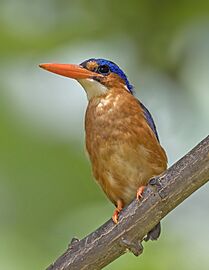Malachite kingfisher facts for kids
Quick facts for kids Malachite kingfisher |
|
|---|---|
 |
|
| C. c. cristatus, Lake Baringo, Kenya | |
| Conservation status | |
| Scientific classification | |
| Genus: |
Corythornis
|
| Species: |
cristatus
|
| Subspecies | |
|
See text |
|
| Synonyms | |
|
Alcedo cristata Pallas, 1764 |
|
The malachite kingfisher (Corythornis cristatus) is a beautiful, small river kingfisher found all over Africa south of the Sahara Desert. These birds usually stay in one place, but sometimes they move around a bit depending on the weather and seasons.
Contents
About the Malachite Kingfisher's Name
The malachite kingfisher was first described by a German scientist named Peter Simon Pallas in 1764. He gave it the scientific name Alcedo cristata. The word cristata comes from a Latin word meaning "crested" or "plumed," which refers to the feathers on its head. The name "malachite" usually refers to a dark green mineral, but this kingfisher is actually bright blue on its back! It also has black stripes with light blue or greenish-blue on its forehead.
Scientists have studied the DNA of these birds. In 2007, they found that the Malagasy kingfisher (Corythornis vintsioides) is its closest relative. The Malagasy kingfisher has a black beak and a greenish crest. It doesn't rely on water as much as the African species. Otherwise, it looks and acts very much like the malachite kingfisher.
Malachite Kingfisher Subspecies
The São Tomé kingfisher and the Príncipe kingfisher were once thought to be separate species. However, a study in 2008 showed that they are actually types, or "subspecies," of the malachite kingfisher.
There are five main types of malachite kingfishers:
- C. c. galeritus (Statius Müller, PL, 1776) – Found from Senegal to Ghana.
- C. c. nais (Kaup, 1848) – Lives on the island of Príncipe off West Africa.
- C. c. thomensis Salvadori, 1902 – Found on São Tomé island.
- C. c. cristatus (Pallas, 1764) – Spreads from Nigeria east to western Sudan, Uganda, and Kenya, and south to Angola, Namibia, Botswana, Zimbabwe, and South Africa.
- C. c. stuartkeithi Dickerman, 1989 – Lives in eastern Sudan, Ethiopia, and Somalia.
-
C. c. cristatus
Namibia -
C. c. galerita
Gambia -
C. c. nais,
Principe island
São Tomé and Príncipe -
C. c. thomensis,
São Tomé island
São Tomé and Príncipe -
C. c. stuartkeithi
Ethiopia
What Does a Malachite Kingfisher Look Like?
This is a small kingfisher, usually about 13 cm (5.1 in) (about 5 inches) long. In Southern Africa, they are around 14 cm, and in East Africa and Ethiopia, they are about 12 cm. The adult bird's upper body is a bright, shiny blue color.
Its head has a short crest of black and blue feathers, which is why it has "cristata" in its scientific name. Its face, cheeks, and underparts are a reddish-brown color, and it has white patches on its throat and the sides of its neck. Young birds have a black beak, but adult birds have a reddish-orange beak and bright red legs. Male and female kingfishers look similar, but young birds are a bit duller in color than the adults.
Where Malachite Kingfishers Live
These birds are commonly found near slow-moving water or ponds, especially where there are reeds and water plants. They live all across Sub-Saharan Africa, except for the very dry parts of Somalia, Kenya, Namibia, and Botswana.
The malachite kingfisher flies very fast. Its short, rounded wings beat so quickly they look like a blur. It usually flies low over the water.
Malachite Kingfisher Behaviour
Reproduction and Nests
Malachite kingfishers build their nests by digging a tunnel in a sandy bank, usually right above water. Both the male and female birds help dig the tunnel. Most tunnels go upwards before reaching the nesting chamber. They usually lay three or four clutches of three to six round, white eggs. The eggs are placed on a bed of fish bones and small, undigested bits of food the birds have coughed up.
How Malachite Kingfishers Find Food
These birds have favorite spots or perches where they like to fish. These spots are usually low over the water. The kingfisher sits upright, with its tail pointing downwards. Suddenly, it will drop into the water with a splash and usually comes right back up with a fish it has caught.
If the food item is large, the bird will hit it against a branch or rail to prepare it. Small fish and insects are swallowed quickly. A fish is usually carried by its middle, but the bird will often toss it into the air to change its position before swallowing it headfirst. Malachite kingfishers eat fish, water insects, and crustaceans like small crabs.







